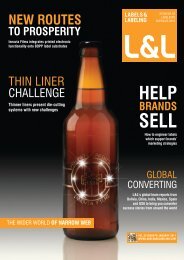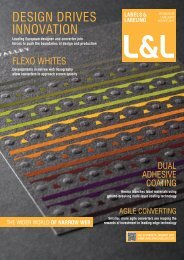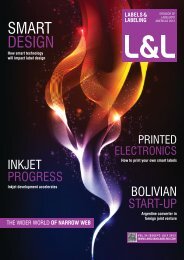THE DATA FRONT
Download as PDF - Labels & Labeling
Download as PDF - Labels & Labeling
- No tags were found...
Create successful ePaper yourself
Turn your PDF publications into a flip-book with our unique Google optimized e-Paper software.
payment applications [as with road or bridge tolls] there are<br />
good reasons to limit the read range and maximize the tag's<br />
security.'<br />
A lack of adequate ROI data was the third-highest ranked<br />
reason for non-deployment according to a survey of 185 retail<br />
organizations conducted by New York-based ABI Research in<br />
mid-2008. 'In times of economic slowdown, a quick positive<br />
return on investment is especially important to potential<br />
RFID users,' said practice director Michael Liard. 'We asked<br />
respondents about their hopes and expectations for ROI on<br />
'"Unit prices have certainly dropped<br />
dramatically from dollars to a few<br />
cents each, but rock-bottom prices are<br />
not everything, neither are long-term<br />
agreements. People remain cautious"<br />
their RFID investments. While a substantial majority saw 12-24<br />
months as a reasonable expectation, more than one third<br />
anticipated a return within the first year.'<br />
Victor Vega, marketing director of California-based Alien<br />
Technology, remembers when RFID chips cost $12 each in<br />
the mid-1990s when the company was founded: 'Unit prices<br />
have certainly dropped dramatically from dollars to a few<br />
cents each, but rock-bottom prices are not everything, neither<br />
are long-term agreements. People remain cautious. Some<br />
Some RFID basics<br />
Radio frequency ID tags use inlays comprising an integrated circuit, or<br />
silicon chip, and an antenna. They allow encoded data to be remotely<br />
received and transmitted to a hand-held or fixed-mount reader (or<br />
scanner), importantly beyond the line of sight of the recording method<br />
and for more than one item at a time. The reader decodes the data for<br />
processing by a host computer. Inlays have many different designs<br />
and sizes to suit specific applications. The more sophisticated types<br />
allow users to both read and write data. Chipless, chip-based and<br />
electromagnetic ID tags, commonly called 'smart labeling', are linked<br />
with RFID technology.<br />
High-frequency (HF) tags have a near-field sensitivity of around 5<br />
feet (1.5 m), which suits many everyday applications, and a global<br />
operating frequency of 13.56 MHz. Lately, more powerful ultra-high<br />
frequency (UHF) tags with longer reading ranges have become more<br />
prominent. They operate with data communication rates from 860<br />
to 960 MHz. The usual passive types are powered by the reader, as<br />
opposed to active tags which require an internal battery. UHF tags are<br />
increasingly associated with the Gen 2 protocol, a user-driven standard<br />
from EPCglobal (formally called Electronic Product Code Class 1<br />
Generation 2 and ISO approved in 2006).<br />
may 2009 | L&L
















